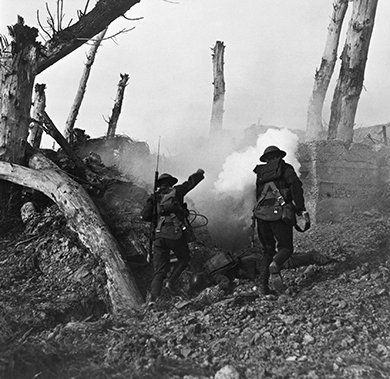| << Chapter < Page | Chapter >> Page > |
The American role in World War I was brief but decisive. While millions of soldiers went overseas, and many thousands paid with their lives, the country’s involvement was limited to the very end of the war. In fact, the peace process, with the international conference and subsequent ratification process, took longer than the time U.S. soldiers were “in country” in France. For the Allies, American reinforcements came at a decisive moment in their defense of the western front, where a final offensive had exhausted German forces. For the United States, and for Wilson’s vision of a peaceful future, the fighting was faster and more successful than what was to follow.
When the United States declared war on Germany in April 1917, the Allied forces were close to exhaustion. Great Britain and France had already indebted themselves heavily in the procurement of vital American military supplies. Now, facing near-certain defeat, a British delegation to Washington, DC, requested immediate troop reinforcements to boost Allied spirits and help crush German fighting morale, which was already weakened by short supplies on the frontlines and hunger on the home front. Wilson agreed and immediately sent 200,000 American troops in June 1917. These soldiers were placed in “quiet zones” while they trained and prepared for combat.
By March 1918, the Germans had won the war on the eastern front. The Russian Revolution of the previous year had not only toppled the hated regime of Tsar Nicholas II but also ushered in a civil war from which the Bolshevik faction of Communist revolutionaries under the leadership of Vladimir Lenin emerged victorious. Weakened by war and internal strife, and eager to build a new Soviet Union, Russian delegates agreed to a generous peace treaty with Germany. Thus emboldened, Germany quickly moved upon the Allied lines, causing both the French and British to ask Wilson to forestall extensive training to U.S. troops and instead commit them to the front immediately. Although wary of the move, Wilson complied, ordering the commander of the American Expeditionary Force, General John “Blackjack” Pershing, to offer U.S. troops as replacements for the Allied units in need of relief. By May 1918, Americans were fully engaged in the war ( [link] ).

In a series of battles along the front that took place from May 28 through August 6, 1918, including the battles of Cantigny, Chateau Thierry, Belleau Wood, and the Second Battle of the Marne, American forces alongside the British and French armies succeeded in repelling the German offensive. The Battle of Cantigny, on May 28, was the first American offensive in the war: In less than two hours that morning, American troops overran the German headquarters in the village, thus convincing the French commanders of their ability to fight against the German line advancing towards Paris. The subsequent battles of Chateau Thierry and Belleau Wood proved to be the bloodiest of the war for American troops. At the latter, faced with a German onslaught of mustard gas, artillery fire, and mortar fire, U.S. Marines attacked German units in the woods on six occasions—at times meeting them in hand-to-hand and bayonet combat—before finally repelling the advance. The U.S. forces suffered 10,000 casualties in the three-week battle, with almost 2,000 killed in total and 1,087 on a single day. Brutal as they were, they amounted to small losses compared to the casualties suffered by France and Great Britain. Still, these summer battles turned the tide of the war, with the Germans in full retreat by the end of July 1918 ( [link] ).

Notification Switch
Would you like to follow the 'U.s. history' conversation and receive update notifications?